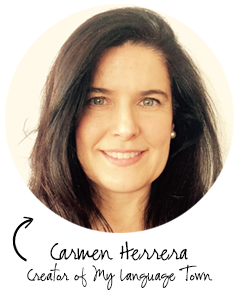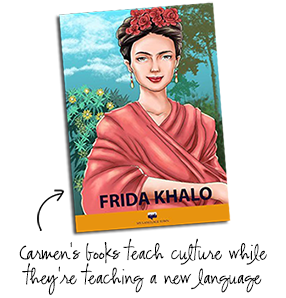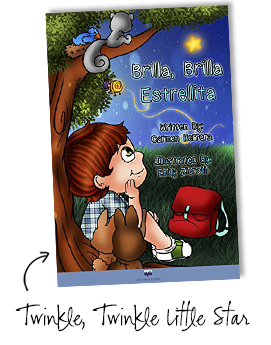Remember memorizing hundreds of verb conjugations when you were learning a foreign language, and racking your brain to recall whether a noun was feminine or masculine? Even if you aced every test, you wouldn’t exactly have called yourself fluent. And, if someone gave you a book to read in the language, you barely made it through the first chapter. What’s more, everything you learned seemed to evaporate from your brain once you graduated school.
You’d love to be able to speak a second language now, but aren’t motivated to start memorizing verbs again. Although you’ve been tempted to buy Rosetta Stone, it’s so expensive. Besides, you’d probably use it only a handful of times, kind of like the treadmill that collected dust for years. And wouldn’t it be nice to converse in Spanish with your 10-year-old grandson or granddaughter, who started learning the language as a new fifth grader?
 Now you can do both with a revolutionary program, called My Language Town, conceived by Carmen Herrera, a 40-something Spanish instructor at the prestigious Dalton private school in New York City. Born in Cordoba, in southern Spain, Carmen has been learning and teaching foreign languages ever since she was young.“My father was a school superintendent and my mother was a kindergarten teacher, and we always had exchange students from all over Europe staying at our home, which shaped how I see people,” Carmen told me. “Learning someone else’s language gives you more empathy to them.”
Now you can do both with a revolutionary program, called My Language Town, conceived by Carmen Herrera, a 40-something Spanish instructor at the prestigious Dalton private school in New York City. Born in Cordoba, in southern Spain, Carmen has been learning and teaching foreign languages ever since she was young.“My father was a school superintendent and my mother was a kindergarten teacher, and we always had exchange students from all over Europe staying at our home, which shaped how I see people,” Carmen told me. “Learning someone else’s language gives you more empathy to them.”
Although Carmen acknowledges the importance of learning grammar, like knowing how to conjugate verbs and gender agreement, when studying a new language, she recognized early on that reading “was usually missing” during the process.
 “There’s a lot of grammar and vocabulary, but not enough reading in the classroom, yet the power of reading is tremendous for anyone learning a language,” Carmen believes. “You can practice grammar and vocabulary with thousands of sentences over the years, but you probably won’t remember anything about the ‘experience’ or recall a single sentence. Learning a new language through a grammar-based method, or using only a textbook, usually lacks emotion. Scientific research tells that most of our fluency–our ability to use a language–comes from what we read and hear,” Carmen says.
“There’s a lot of grammar and vocabulary, but not enough reading in the classroom, yet the power of reading is tremendous for anyone learning a language,” Carmen believes. “You can practice grammar and vocabulary with thousands of sentences over the years, but you probably won’t remember anything about the ‘experience’ or recall a single sentence. Learning a new language through a grammar-based method, or using only a textbook, usually lacks emotion. Scientific research tells that most of our fluency–our ability to use a language–comes from what we read and hear,” Carmen says.
An out-of-the box thinker, Carmen always tries to find new ways to “get to” her students. My Language Town offers educational eReaders to help students dive deeper into the Spanish language, and culture, at any age or level.
 The engaging and lively stories also make grammar and spelling comprehensible and fun. “You can teach a language using the grammar approach, the vocabulary approach, or the communicative approach, and so many teachers feel they have to follow one method, but the beauty of My Language Town is that it offers a combination of approaches,” Carmen explains. A child in one of her 45 books tells his mother why he’s not happy with the weather, for example. “He will learn the vocabulary related to the weather, as well as the grammar, but feelings and emotions also are incorporated into the book in a memorable way,” she says. Most of the books are written in dialogue, exactly like spoken Spanish, so the students relate more to the characters, the situations and their emotions. “The stories, structures, expressions, cultural situations stick better, and with less effort,” Carmen adds.
The engaging and lively stories also make grammar and spelling comprehensible and fun. “You can teach a language using the grammar approach, the vocabulary approach, or the communicative approach, and so many teachers feel they have to follow one method, but the beauty of My Language Town is that it offers a combination of approaches,” Carmen explains. A child in one of her 45 books tells his mother why he’s not happy with the weather, for example. “He will learn the vocabulary related to the weather, as well as the grammar, but feelings and emotions also are incorporated into the book in a memorable way,” she says. Most of the books are written in dialogue, exactly like spoken Spanish, so the students relate more to the characters, the situations and their emotions. “The stories, structures, expressions, cultural situations stick better, and with less effort,” Carmen adds.
“A book will have sentences like, ‘María is wearing a shirt. The shirt is blue,’’ rather than ‘Oh, look at Maria. She is wearing a blue shirt.’ No one talks that way,” Carmen laughs. The names of the speakers also are included next to their dialogue, so it’s clear who is talking. “It’s easy to follow, like a script,” she adds. “As a student is reading, he’s following the characters’ questions and answers, learning to speak, and having a real conversation.”


